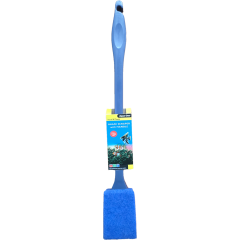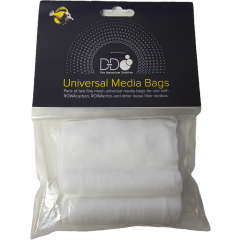
It’s a question that always tests the poker face of retail aquarists when chatting to someone who typically tends to be hanging around the store while their significant other shops in the garden centre. It’s usually spoken in front of a display tank, but sometimes it gets asked of a 4,000-litre system: “How do you catch them all out when you have to clean it?”
As a fishkeeper, it doesn’t take long to realise that myths abound and almost everybody will meet a friend or family member who used to take their fishbowl or tank to the sink, net the fish out and empty the entire container before washing everything and putting the fish back into a squeaky clean, chlorinated environment. The fact that the fish survived as long as they did was testament to the hardiness of (usually) goldfish and the feeling that this was the way to do things. After all, the same applies to hamsters, rabbits, chickens and pretty much every other household pet – it’s all about the cleaning out. With wisdom comes insight, and the knowledge that an aquarium is a self-contained ecosystem where dynamic natural processes are important to the health of the occupants. In less florid language – the more you try to clean your tank like a hamster cage, the more likely you are to kill your pets!
The best mantra to recite when cleaning an aquarium is ‘Dirty filter, clean water’ and this highlights the need to preserve your filter bacteria in any system where fishes are present. Filters do benefit from cleaning, but this is mostly about removing detritus and providing opportunities for new, efficient bacterial colonies to grow on clean surfaces by rinsing off biofloc. When cleaning a mature filter, old aquarium water is perfect for this job, as it is free of bacteria-killing chlorine and is a waste product (although perfect for watering plants if not from a marine aquarium).
Tempting though it may be, never wash mature filter media such as foam inserts under the tap unless you have unwashed media to carry the load until the bacteria recover. Don’t try to get biomedia such as foam spotless, instead try to make it free of solids and unclog the internal pore structure. Foam does age and decline, with the result that the void spaces that allow water to flow through the filter are blocked and the filter clogs rapidly. Keeping your foams free of solid waste will help to maximise their useful life, as well as reducing nitrate accumulation and removing pathogens that are able to inhabit organic waste in a free-living form away from a fish host. It’s a good idea to rinse 50% of your biological media at a time and this can be alternated with each water change. If your filter needs more frequent rinsing, it may be too small for the waste load or time for a new sponge. As an alternative, a sludge buster additive can sometimes remove the accumulated organics and extend the useful life of your media. To return washed biomedia to peak performance quickly (useful in heavily stocked systems) boost bacterial populations by adding an inoculant, such as one of the Microbe-Lift products: https://www.fishkeeper.co.uk/microbe-lift-gel-filter.
Having preached the gospel of bacteria preservation, let’s take a look at the more mundane aspects.
Glass Cleaners
In order to make your cleaning as efficient as possible, it’s important to get things in the right order. Cleaning the glass will often cloud the water a little, as algae is removed and put into suspension. Rather than mess up clean water, carry out any algae wiping before a water change. Depending on the job in hand, there’s a range of glass cleaning equipment including algae magnets, scrapers and pads. Make sure that whatever you use, you avoid trapping sand or gravel between them and the glass. For hard algae growth, such as the little green spot form, an old credit or reward card can be just the thing. It might not get you nectar points anymore, but it’ll certainly remove stubborn algae without scratching the glass.
It can be annoying to find you’ve missed a spot, so check the front glass is clean by looking through the side pane where any remaining algae will be much easier to spot from the side. Of course, if you have fish that appreciate it and it’s not too unsightly, you may wish to leave algae growing on any surfaces that you don’t need to see through. This can be especially useful if you have added algae-eaters such as snails to your aquarium, which will appreciate the browsing opportunity.
Find More Cleaning Products Here
Gravel Cleaners
With the glass cleaned, it’s time to remove some water. Rather than just siphoning out water, it’s a great opportunity to remove detritus and debris. By using a gravel-cleaning siphon, solid waste can be removed before it breaks down to fuel algal growth or remains in dead spots to shelter parasites. It can be a good idea to move the décor around to enable thorough cleaning but make sure that favoured hiding places or territorial markers are replaced to avoid potential conflict. The design of gravel cleaners makes them perfect for removing waste from deep substrates, if you use sand rather than gravel simply raise them higher in the water column to avoid picking up too much of the substrate.
Filter Media
Once the water has been removed from the tank, it can either be used to rinse filter media as explained above, or (as long as it’s not salt water!) it can be used for watering plants, which will appreciate the nitrates and phosphates it contains.
Testing your aquarium for nitrate can help to determine how much and how often you should be performing partial water changes. Heavily fed and stocked set ups, such as fry rearing tanks, can be given daily 50% changes if carried out correctly. This is also the best way to rejuvenate a neglected aquarium and changing 50% of the water daily for two days is far less stressful than replacing 75% of the water. Messy fishes like Goldfish and Malawi cichlids will enjoy largescale weekly or even daily changes, whereas Tanganyikan cichlids and reef aquaria will be better served by smaller changes.
Old water needs replacing with new water and it’s a good idea to have two duplicate containers to make refilling the aquarium easier. If your tap water is particularly high in nitrates or phosphates, then you might want to use purified reverse osmosis (R.O.) water which is available from many stores and should always have minerals added to restore mineral content. It’s good to minimise any drastic differences between new and old aquarium water to avoid shocking your pets. Allowing new water to sit overnight to get to room temperature will avoid thermal shock and if you have a large aquarium, a container such as a water butt can help you process large volumes of water as part of your regular schedule. As there’s more to tap water than chlorine, it’s always worth using a tap water conditioner to avoid any unpleasant surprises https://www.fishkeeper.co.uk/aquarium-products/treatments
Evaporation is a process which can distil that mineral and waste content of your aquarium and it’s important not to think of this as a means to change water. As only pure water evaporates it leaves behind minerals and dissolved waste, making your aquarium harder and more polluted. This is the only circumstance where adding R.O. or other demineralised water without added minerals is appropriate. A better option is removing more water and carrying out a water change to reduce pollutants.





























